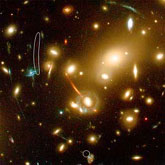Hubble & Keck Teams Find Farthest Known Galaxy in Universe
 An international team of astronomers may have set a new record in discovering what is the most distant known galaxy in the universe. Located an estimated 13 billion light-years away, the object is being viewed at a time only 750 million years after the big bang, when the universe was barely 5 percent of its current age. The primeval galaxy was identified by combining the power of NASA's Hubble Space Telescope and CARA's W. M. Keck Telescopes on Mauna Kea in Hawaii. These great observatories got a boost from the added magnification of a natural 'cosmic gravitational lens' in space that further amplifies the brightness of the distant object. The newly discovered galaxy is likely to be a young galaxy shining during the end of the so-called 'Dark Ages' -- the period in cosmic history which ended with the first galaxies and quasars transforming opaque, molecular hydrogen into the transparent, ionized universe we see today.
An international team of astronomers may have set a new record in discovering what is the most distant known galaxy in the universe. Located an estimated 13 billion light-years away, the object is being viewed at a time only 750 million years after the big bang, when the universe was barely 5 percent of its current age. The primeval galaxy was identified by combining the power of NASA's Hubble Space Telescope and CARA's W. M. Keck Telescopes on Mauna Kea in Hawaii. These great observatories got a boost from the added magnification of a natural 'cosmic gravitational lens' in space that further amplifies the brightness of the distant object. The newly discovered galaxy is likely to be a young galaxy shining during the end of the so-called 'Dark Ages' -- the period in cosmic history which ended with the first galaxies and quasars transforming opaque, molecular hydrogen into the transparent, ionized universe we see today.
The new galaxy was detected in a long exposure of the nearby cluster of galaxies Abell 2218, taken with the Advanced Camera for Surveys on board the Hubble Space Telescope. This cluster is so massive that the light of distant objects passing through the cluster actually bends and is amplified, much as a magnifying glass bends and magnifies objects seen through it. Such natural gravitational 'telescopes' allow astronomers to see extremely distant and faint objects that could otherwise not be seen. Analysis of a sequence of Hubble images indicate the object lies in between a redshift of 6.6 and 7.1, making it the most distant source currently known. However, long exposures in the optical and infrared taken with spectrographs on the 10-meter Keck telescopes suggest that the object has a redshift towards the upper end of this range, around redshift 7.
Redshift is a measure of how much the wavelengths of light are shifted to longer wavelengths. The greater the shift in wavelength toward the redder regions of the spectrum, the more distant the object is. The extremely faint galaxy is so far away its visible light has been stretched into infrared wavelengths, making the observations particularly difficult. Using the combination of the high resolution of Hubble and the large magnification of the cosmic lens, the astronomers estimate that this object, although very small -- only 2,000 light-years across -- is forming stars extremely actively. However, two intriguing properties of the new source are the apparent lack of the typically bright hydrogen emission line and its intense ultraviolet light which is much stronger than that seen in star-forming galaxies closer by.
Fact Credit
NASA Headquarters


